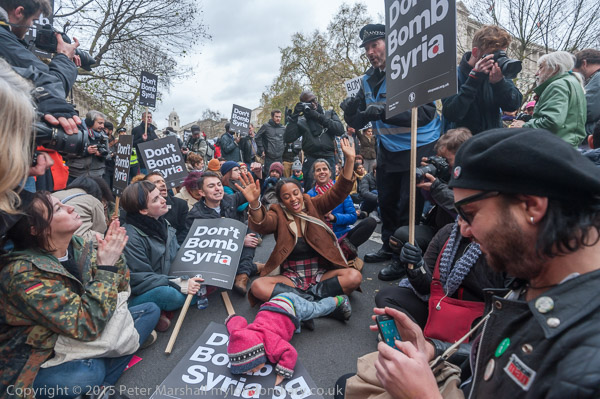March for Climate Action Starts
Gathering and Initial Rally
Park Lane, London. Sun 29 Nov 2015
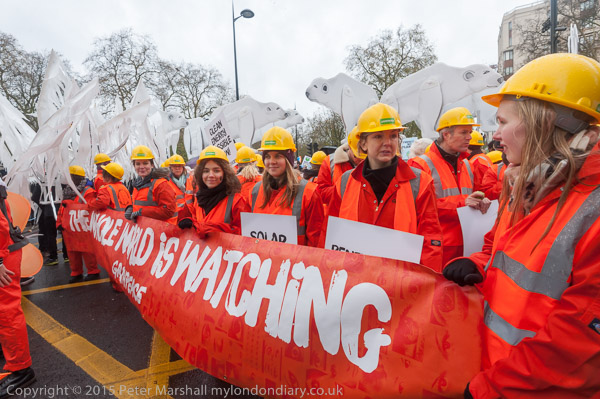
The Greenpeace banner 'The Whole World is Watching'
and polar bears
more pictures
Park Lane was beginning to fill up with people as I arrived early for the March for Climate action, one of about 2,500 events around the world on the weekend before the start of the COP21 talks in Paris, where 147 heads of state and government are to meet and try to agree on limiting carbon emissions in the hope of limiting global warming.
The London protest was said to to be the second largest of these events, with an estimated 50,000 people taking part - out of a roughly 600,000 involved in the world-wide protests, just 10,000 less than the protest in Melbourne. It had an extra impetus from the ban on protests in Paris, with many from the UK who would otherwise have travelled there protesting in London instead.
The protest was attended by a fairly bewildering range of groups, coming together from very different perspectives, but all deeply worried about the impact of man-made climate change. As well as the group which started annual climate marches in London and organised them in the first almost ten years, the Campaign Against Climate Change, there were other environmental groups including Greenpeace and Friends of the Earth, on-line protest groups such as Avaaz and 38 degrees, large aid charities including Action Aid and Oxfam, animal charities, political parties, anti-fracking protesters and more who make up the Climate Coalition along with Stop Climate Chaos Cymru and Stop Climate Chaos Scotland. The total membership of all the over 100 UK organisations involved is over 11 million. With so many different groups with so many agendas - and with many appealing to largely apolitical people and with highly paid staff at the top - its hardly surprising that the event has lost at least some of its political bite.
Before the march started I made an attempt to take pictures of as many of the different groups involved as possible, working my way slowly up Park Lane, though it soon got so crowded that it became difficult to move or get enough space to take pictures.
I made my way back to the front of the march, where a rally was taking place with speakers standing on the Fire Brigades Union fire engine. Useful though this is as a mobile platform, it presents something of a nightmare for photographers, with ugly pipe-work obstructing our view of the speakers.
The first speeches, most of which I missed completely, being too far away in the crowd were by people from the Global Frontlines bloc, representing countries mainly the Global South who are most exposed to the risks of climate change - and which is already causing serious problems in many of their countries. It had been agreed by the organisers of the march that their block would lead the march through London. Another speaker I missed was Dame Vivienne Westwood, who had not arrived when I photographed her Climate Revolution group, though I did take a few pictures of her later on the march.
At the end of the rally there were speeches by FBU General Secretary Matt Wrack (it was after all his fire engine), Labour leader Jeremy Corbyn and finally by the sole Green Party MP, Caroline Lucas. Others from the Green Party, including the leader Natalie Bennett, and the two deputy leaders were also on the march, and I had photographed them earlier.
Global Frontlines lead Climate March
Hyde Park Corner to Parliament, London. Sun 29 Nov 2015
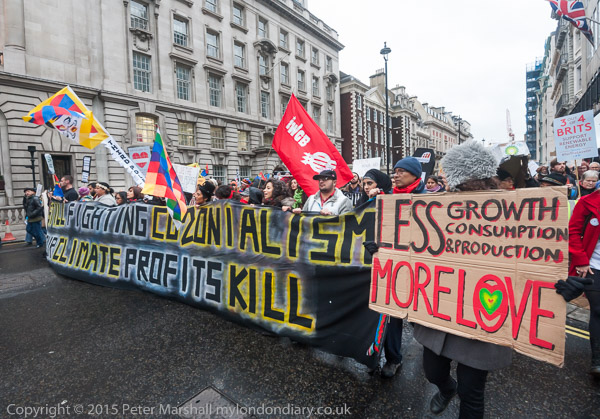
Organisers tried to hide the Global Frontlines bloc
'Still fighting CO2onialism - Your Climate Profits Kill'
more pictures
Although it had been agreed that the march should be led by the Global Frontlines bloc, on the day the organisers, representing the large groups including Avaaz, changed their mind. They decided to put the main march banner along with some of those in carnival animal costumes at the front of the march as they felt the Global Frontline was too radical. They actually wanted system change not sops.
The organisers tried to outflank the Global Frontlines, sending animal costumed carnivalistas in front of them, but they moved back to the front. For the first time ever, march organisers had employed commercial security guards rather than relying on volunteer stewards, and they were ordered to hold back the bloc, and to try to remove some of the more political placards and coffins that were being carried.
There were tussles, but the protesters stood their ground, and repelled the security guards. The organisers then called the police to try and enlist their help to move the bloc from the front of the march, but other than passing on the organisers' request I understand they sensibly refused to try to illegally remove the bloc. The whole argument was a disgraceful attempt to de-politicise the event and to marginalise those facing the sharp end of climate change, and one which they successfully resisted.
Most of this took place while I was on my way to the front of the march, photographing some of the marchers, including anti-fracking groups from Lancashire - the 'Nanas from Nanashire' including the redoubtable Tina-Louise Rothery - and the people carrying the main banner 'The People's March for Climate & Jobs', accompanied by giraffe and other animal costumed marchers as well as representatives of other groups, which had stopped to put a gap between it and the Global Frontlines.
The banner at the front of the Global Frontlines bloc - and thus march as a whole - read 'STILL FIGHTING CO2ONIALISM YOUR CLIMATE PROFITS KILL' and there were others with anti-colonial messages including 'Extractivism is Colonialism' and other anti-mining sentiments. Apparently what worried the more conservative charities most was the message 'British Imperialism causes Climate Change' as well as two coffins naming companies BP and BHP Billiton.
In the Global bloc were others carrying banners and posters calling for reparations
for the effects of colonialism and an end to neo-colonialism. There were several
large posters 'The Wretched of the Earth' (the title of Fanon's brilliant
analysis of the psychological effects of colonisation and the path to liberation
from it), and
many posters about environmentally disastrous mining operations, mainly by
London-listed companies. The bloc included a strong South American presence,
with the 49 coloured square Wiphalas of the pro-indigenous movements
in Colombia, Ecuador, Peru, Bolivia, Argentina and Chile.
The group carrying the main banner included Peruvians in traditional dress and a placard stated 'Long Live the Peruvian People's Struggle'. Further along it were a group with prominent face markings holding up sheets with 'PEC 215' crossed out in opposition to the Brazilian constitutional amendment which will remove land rights from indigenous people, and a large banner with the message '43?' was a reminder of the 43 Mexican students captured by police and handed over to a drug gang in Ayotzinapa in September 2014. Also marching with them were many British supporters, including the 'Black Dissidents' and others in the UK civil rights movements, raising the killing of black people by police in the UK and USA.
The march organisers sent requests to the marchers in the bloc while I was taking pictures for them to get back behind the main banner, and the group stopped for a brief consideration. But it was extremely brief, with a loudly expressed unanimous resolve to keep in the front of the march as had been agreed beforehand.
It seemed then that the organisers were trying to separate this bloc from the rest of the march by slowing that down and creating a gap. But this didn't really happen, and when the bloc sat down on Pall Mall a few yards from the BP head office, as a protest against that companies environmental destruction around the world and its collaboration with brutal repression of workers in some projects, the main body of the march caught up with them, many of the marchers streaming past the 'The People's March for Climate & Jobs' banner which the organisers had tried to put in the lead, along with its white rabbit and giraffes.
I marched to Parliament Square with the Global Frontlines bloc and Vivienne Westwood's Climate Revolution and others who were now right behind them, and climbed onto the anti-tank defences in front of Parliament to watch for a few minutes as the rest of the march arrived behind them. I was pleased to see that the main banner was now preceded by a large flag for the Campaign Against Climate Change.
There were two giant screens, one close to the Victoria Tower at the end
of the Houses of Parliament and the second, around a quarter of mile down
Millbank next to the stage where a rally was starting. It was hardly inspiring,
and after listening for a while and taking a few pictures of the crowd I walked
slowly back towards Parliament taking pictures of a few people in it. Rather
more was happening in Parliament Square, were people were still arriving on
the march, with the Vegans in particular making themselves known. Several
of the bands from the march had stopped there and were playing. But by now
I was rather tired and made my way to the station.
more pictures
Don't Bomb Syria
Downing St, London. Sat 28 Nov 2015
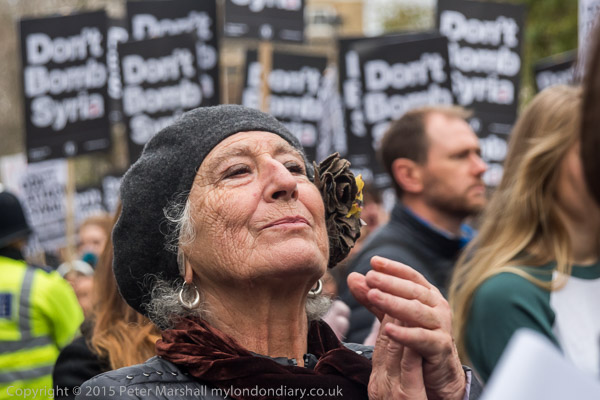
A woman listens to the speeches at the rally in the
middle of Whitehall
more pictures
Several thousand people came to Downing St to urge MPs not to support British air strikes on Syria, saying a diplomatic solution should be found to the conflict. They expressed strong support for Jeremy Corbyn's principled stand and urged all Labour MPs to back him.
When I arrived well before the protest was due to start, a hundred or so people, some with placards, were milling around in front of the gates to Downing St, with police trying to clear them away so that barriers could be put down on that side of the street. Eventually more police came and persuaded them all to move across to the other side of the road where a large crowd was already standing with placards and banners.
Five minutes before the event was due to start there were too many to keep on the pavement, and police closed the south-bound carriageway to let them come out onto it and in front of the platform for the speakers in the central area, with a row of barriers meant to keep them away from the traffic still going north on the other side of the road.
By the time the speeches began, that area was pretty full, with people filling
it for several hundred yards up Whitehall, as well as some standing across
the road on the pavement.
more pictures
Speakers at Don't Bomb Syria Rally
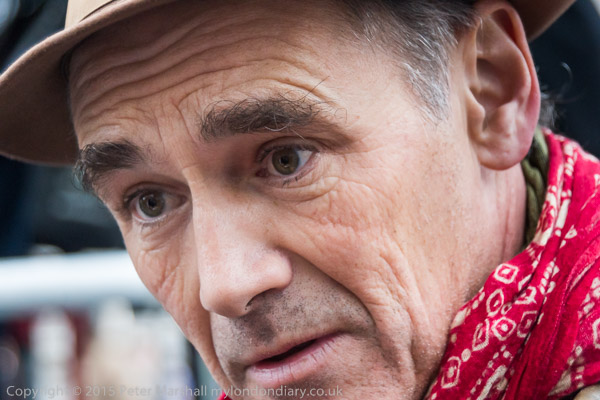
Actor Mark Rylance
more pictures
The speakers were introduced by Andrew Murray of Stop the War and Unite, and included Musician Brian Eno, Actor Mark Rylance, British Pakistani writer, journalist, and filmmaker Tariq Ali, Lindsey German of Stop the War, Green Party Deputy Leader Shahrar Ali, NUT Vice President Philipa Harvey, John Rees of Stop the War and People's Assembly, The Guardian and New Statesman columnist Owen Jones, Unite Against Fascism Joint secretary Sabby Dhalu, George Galloway, CND Chair Kate Hudson and John Hilary, Executive Director of War on Want. MP Diane Abbott (like some others) was held up in traffic and arrived after I had moved across to photographing the sit-down.
There were some fine speeches, particularly from Tariq Ali (always a pleasure to watch whatever he says) and some good points were made, particularly about the need to take effective action against the Turkish complicity in Daesh oil exports, in which members of Erdogan's family take a leading role, and against what Tariq Ali described as "the obscenity of the Wahabi regime in Saudi Arabia' which provides the fanatical religious basis and much funding for Daesh. And, always in the background, the continuing crisis over Palestine.
But I was left waiting and wanting. There with notebook poised ready to write
down the names of the speakers representing the Syrians and the Syrian Kurds,
who should surely have been at the forefront of this protest rather than so
many old 'Stop the War' war-horses. None came, not because none were available
or willing to speak, but because the politics of those most closely involved
don't accord with those of Stop the War.
more pictures
Don't Bomb Syria Blocks Whitehall
A young mother shouts and waves her hands while her
chile plays with Don't Bomb Syria placards
more pictures
While the speeches were taking place there were several attempts by people to move on to the north-bound carriageway of Whitehall, with police surrounding them and trying to move them back. For a while buses and other traffic was able to move slowly through, but eventually more people came onto the road and it became impossible to keep it clear.
People sat down and chanted 'Don't Bomb Syria' and other slogans and sat blocking the highway until well after the rally had finished. After around an hour the police, who had been going around for some time asking people to move with little success stepped up their action. More police had arrived and the began to tell people that they would face arrest unless they moved. Slowly and reluctantly people began to get up, and eventually everyone was back on the pavement.
Some were still staying there to protest, but more and more were moving away
and it looked as if the protest was more or less over, so I left too.
more pictures
Stop Killing Cyclists Die-in
TfL Offices, Blackfriars Rd, London. Fri 27 Nov 2015
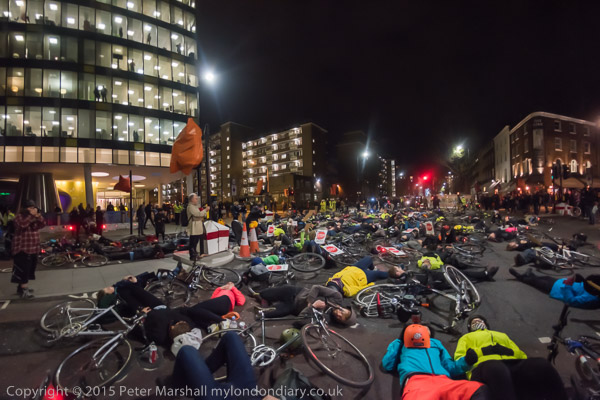
The die-in blocked Blackfriars Rd and the junction for
around 15 minutes
more pictures
Cyclists held a rally outside the HQ of Transport for London with 21 coffins for the 21 cyclists killed on London streets in the last 2 years. After music and speeches they staged a die-in, closing the junction there for 15 minutes.
The rally came two years after an earlier die-in at the same location which followed the killing of six cyclists in a terrible fortnight on London roads. The great majority of deaths of cyclists are caused by drivers of heavy goods vehicles, particularly skip lorries, which tend to have very limited vision vision behind and to the side and are unaware of the presence of cyclists.
Since 2013, there has been some very limited progress on cycle safety, with
some improvements to cycle superhighways and other measures, and a greater
awareness of the problem, but much more needs to be done. This year's protest
included a row of 21'coffins' outside the TfL offices, one for each cyclist
killed in the two years since the previous die-in here.
There was a rather different atmosphere from the 2013 protest, with TfL and
police appearing to adopt a more relaxed attitude. With no shocking series
of recent killings it was perhaps not surprising that the protest was noticeably
less well attended this time, but there were still plenty to block the junction
for the die-in.
Prior to the protest 'Stop Killing Cyclists' who organised it had sent a questionnaire to all the London mayoral candidates asking to indicate whether they supported the demands for safer cycling - which are also demands that would make London safer for pedestrians and healthier for us all that are in the “10% by 2020” London Mayoral Cycle Safety Challenge.
Specifically this calls for:
- 10% of TfL budget by 2020 to be spent on cycling safety,
- full blind-spot safety equipment to be fitted in all existing and new HGVs, buses, coaches and Tipper Trucks entering London,
- funding for Mini-Holland Programmes for all London Boroughs,
- a comprehensive grid of Go-Dutch standard physically protected cycle-routes across London,
- a 20mph London speed limit (except on motorways),
- allowing cyclists to turn left (with full pedestrian priority) at red lights when traffic allows - and an emergency programme of installing at least 500 safe protected left-hand turns as promised by Boris but not delivered,
- an end to the the lethal paid by timed delivery regimes for HGVs in the construction industry and similar bus performance systems
- traffic free major squares and shopping streets
- two TLF board places for cyclists
- a rush hour ban on tipper trucks and the use of electric delivery trucks and cargo bikes to bring inner London deliveries from outer London HGV parks.#
Only two of the candidates supported the key 10% of TfL budget demand, Sian Berry of the Green Party, who attended the vigil and Independent Rosalind Readhead whose platform is to ban private cars from London's Zone 1 & 2 (and was probably also present as she has been at some earlier cycle protests.) Neither Sadiq Khan (Labour) nor Zac Goldsmith (Tory) would make any specific financial commitment to cycling, though Khan promised a "significant" increase. Liberal Democrat Caroline Pidgeon promised at least 3% and more if cycling exceeded 3% of traffic.
There was more agreement with some of the other demands with all five supporting the pedestrianisation of Oxford St, to consider allowing left turns at red lights, to have more Mini-Hollands and support some retrofitting of blind-spot safety equipment.
The vigil began with several numbers from a vocalist (Ted Browne?) and a keyboard player before speeches announced by from Tom Kearney who was lucky to survive as a pedestrian run over by a bus on Oxford St, and Deborah Willemen, a Belgian mother who was knocked off her bicycle a few months after moving to London.
Professor Brendan Delaney, a doctor working in London, put the actual deaths from road accidents into proportion, as air pollution, mainly from traffic, particularly diesel-engines in buses and lorries, is thought to kill around 7,000 a year in London. Safer cycling would put many more cyclists on the roads, reducing pollution significantly as well as providing exercise that would contribute to health. A cyclist and a doctor, he would like to be able to encourage many more of his patients to cycle in London.
A more personal and moving account came from Victoria Lebrec who was run over by a skip lorry in December 2014. Her life was saved when London Air Ambulance doctors stopped the bleeding but later she had her left leg amputated at the Royal London. She broke into tears as she bravely called for more to be done to make cycling safer.
Peter Hartley, Chair of Westminster Living Streets called on Westminster to do more to prevent pedestrians and cyclists being killed, and of the need to argue against those who oppose measures to make London safer for both cyclists and pedestrians, angry motorists who write letters to the papers. Westminster and other councils currently largely serve the interests of such drivers in their road planning.
Cycling campaigner Alex Raha read a funeral poem for cyclists and eight year old Scarlett Brady Hughes read out the names of the 21 cyclists killed before cyclists walked out onto the roads with their bikes for the silent die-in. Police stood back as stewards stopped the traffic for this. Once the traffic was stopped they went to explain to those in the queues what was happening and why, and although a number of motorists made U-turns and drove away, I heard none of the angry blowing of horns that usually accompanies any traffic stoppage in London.
After the 15 minute die-in the road was rapidly cleared and traffic was quickly
moving again, and there was a final speech on the pavement in front of the
TfL offices by Donnachadh McCarthy of Stop Killing Cyclists, co-organiser
of the event with Nicola Branch. As I left those taking part were singing
the closing song, Queen's 'I love My Bike'.
more pictures
Ripper 'Museum' Candlelit Vigil
Cable St, London. Thu 26 Nov 2016
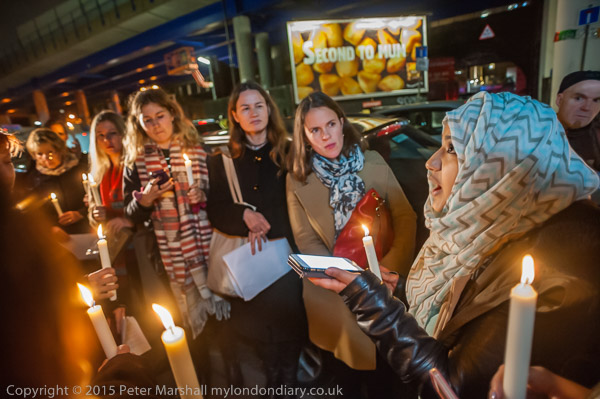
A woman from the local Citizen's UK speaks at the vigil
more pictures
A candlelit vigil and rally outside the Jack the Ripper 'museum' was followed by a commemoration of his victims at the local church making the start of 16 days of action against violence against women - more than 2 are killed each week in the UK.
The vigil was planned by the local Church of England and supported by the Theology centre at St George’s and London Citizens’ Whitechapel HQ as well as various women's groups and celebrated the lives of the victims of the serial killer who horrendously mutilated his victims - as the museum shows for the titillation of visitors.
But the vigil, which included an address by historian Sarah Jackson who is campaigning for “a real heritage centre” about the women of the East End - which the Ripper 'museum' pretended it would be - included readings of the brief details that are known about the women that were killed rather than any details of the terrible murders of Mary Kelly, Polly Nichols, Annie Chapman, Elizabeth Stride and Catharine Eddowes - whose great-great-great granddaughter Jean Smith and her daughter Tracy were at the event.
When the vigil started, an employee was working to clean inside the 'museum' and he left while the vigil was taking place. He shouted to the local newspaper photographer who was present 'Don't take my photograph!' and then lunged at him as he did, grabbing his camera and assaulting him. Police who had been sitting inside a van next to the vigil jumped out and separated the two men. The 'museum' employee then accused the photographer of assault, despite the crowd of witnesses present who had seen him attack the photographer.
The police seemed very reluctant to take action, failing to arrest the employee. Possibly their reluctance was because unless they were neglecting their duty of keeping an eye on the protest they cannot have failed to see the assault. Later as I walked away from the church past their van they were discussing the case over the radio and seemed to be rather worried about it.
The vigil continued, with a minute of silence for the women, and at the end we were all invited to walk the short distance to St George’s-in-the-East in a candle-lit procession to a service of remembrance there. I went with them to the church but had to leave to catch a train before the service.
People in the area still hope to set up a permanent museum about the women
of the East End, and a exhibition has been announced to take place at St George's
for next year's International Women's Day and to be shown later at both St
Paul’s in The Highway and St Mary’s in Cable Street.
more pictures
Class War at Osborne & Little
Chelsea, London. Wed 25 Nov 2015
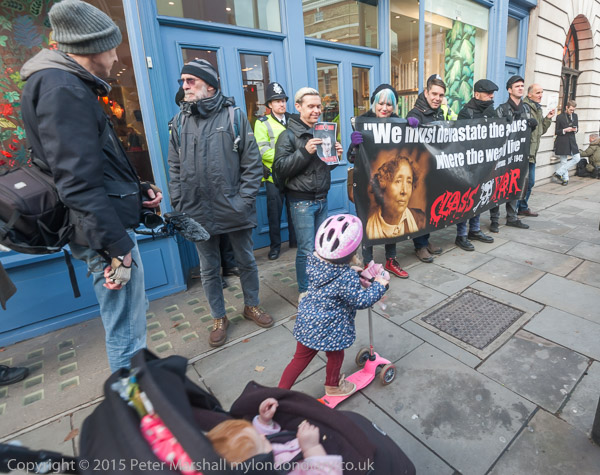
Class War's banner outside Little & Osborne attracted
some interest from those passing by
more pictures
A small group of Class War protesters went to George Osborne's family business to protest at the company's avoidance of taxes while he was announcing savage cuts in public services in the Autumn Statement.
It appears that the family business in wallpaper and other interior decoration materials, despite having a lucrative business with branches in leading cities around the world and trading on-line, manages to arrange its business so as to evade paying corporation tax.
A Channel 4 investigation also found that they had made £6 million
in a property deal with a developer based in the British Virgin Islands, a
tax haven, to redevelop its former London HQ as around 45 flats and houses.
George Osborne is a beneficiary of a family trust which owns at least 15%
of Osborne and Little and so would have profited from the sale. While doubtless
legal, the company's tax arrangements hardly seem fair to those of us who
have little if any choice over paying our taxes.
It's perhaps hardly surprising that although Osborne sometimes talks tough
on chasing up companies that operate in the UK but manage not to pay tax here,
there has been very little actual action to close loopholes and chase up offenders.
This was a peaceful protest and the police simply stood and watched, though
we might feel it something of a waste of public funds that there seemed to
be at least twice as many of them as protesters, and that some of them were
continuing their patrols for at least an hour after Class War had left.
more pictures
Osborne's Nightmare Cuts
Westminster, London. Tue 24 Nov 2015
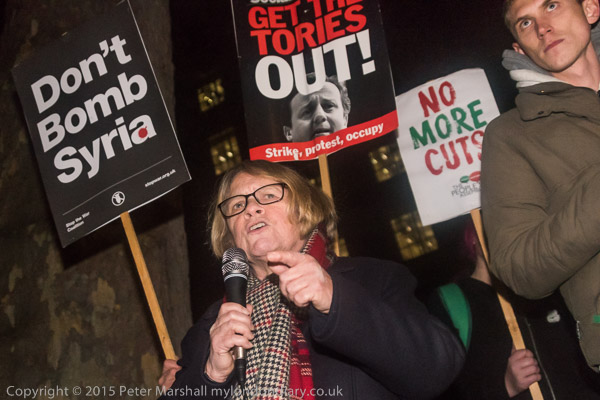
Lindsey German speaks and Sam Fairbairn listens at Downing
St rally
more pictures
On the night before George Osborne's Autumn Statement which will cut billions from welfare while increasing the spending on warfare, the People's Assembly marched in protest from Trafalgar Square to a rally at Downing St.
Nine protesters put on plastic 'heads' of George Osborne to hold up the letters N. I, G, H, T, M, A. R and E, sometimes in that order, for photographers in a dark area of Trafalgar Square, and then behind the People's Assembly 'End Austerity Now' banner at the front of the march as it formed up in Trafalgar Square for the short march to Downing St.
Opposite Downing St there was a rally with speakers including Yannis Gourtsoyannis
of the National BMA Junior Doctors Committee, Green Party Deputy Leader Amelia
Womack, Lindsey German of Stop the War, Labour MP for East Leeds Richard Burgon,
CND Chair Kate Hudson, Paula Peters of DPAC, Andy from Momentum and John Rees,
Romayne Phoenix and Sam Fairbairn of the Peoples Assembly.
more pictures
Class War at the Ripper 'Museum'
Cable St, London. Sat 21 Nov 2015
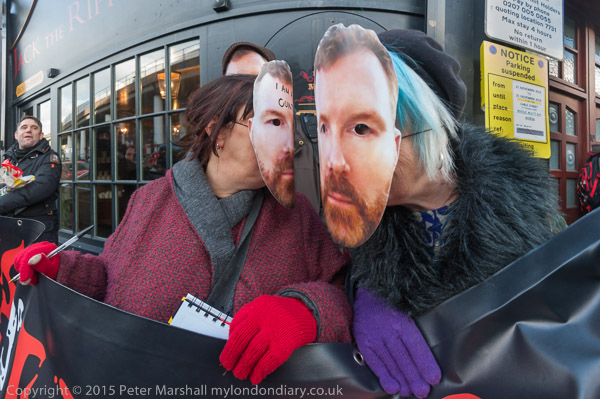
Class War protesters hold banner in masks of the owner
of this tacky tourist attraction
more images
Class War protested again outside the Jack the Ripper tourist attraction in Cable St, which they say is not a museum but a celebration of brutal attacks on women and should be closed down. Cosmo sang protest songs as protesters danced with banners.
Class War continued their series of protests against the Jack the Ripper 'Museum' which celebrates the horrific acts of 'Jack the Ripper', almost certainly Montague Druitt who drowned himself in the Thames shortly after the last of the murders. The museum is a part of an industry which has set itself up around them, doing its best to build up doubt and uncertainty.
Reading the reports in the press (for example) about what is actually on show inside the so-called museum, it seems clear that the exhibits celebrate the work of an insane serial killer who ripped open the bodies of his victims, removing the uterus and heart, and are trying to make a profit from the sensationalisation of his hideous crimes.
There was a little theatre about the protest, with many of those taking part wearing masks with the face of the Museum owner, some with comments about him added. But of course it was peaceful if lively, and the arrival of singer/guitarist Cosmo really made it memorable. The three songs he performed were appropriate and raised everyone's spirits, and even the police were obviously enjoying the protest.
Everyone except perhaps 'museum' owner Mark Palmer-Edgecumbe and his partner Julian Pino who had been left to face the protest from inside the 'museum'. He added an element of mirth by apparently repeatedly phoning '999' during the protest; eventually one of the officers had to go inside to tell him that the police were there and that the protest was both peaceful and lawful.
There was another rather amusing incident, when a man who had obviously rehearsed
his role came up to complain to Class War about the protest. Why, he asked,
were they protesting against a business that was bringing investment to an
area that was so obviously in need of it. He claimed to be a local resident,
but was unknown to those at the protest who have lived in the area for many
years. Perhaps investment in this area is a good thing, but certainly not
investment in businesses as reprehensible as this. It was hard to avoid the
conclusion that this was an intervention prompted and possibly funded by the
owner of this tacky tourist attraction, which noticeably attracted no customers
while the protest was taking place. If the protests don't close it down, commercial
failure should do so.
more images
Homes for All against social cleansing
Leyton, London. Sat 21 Nov 2015
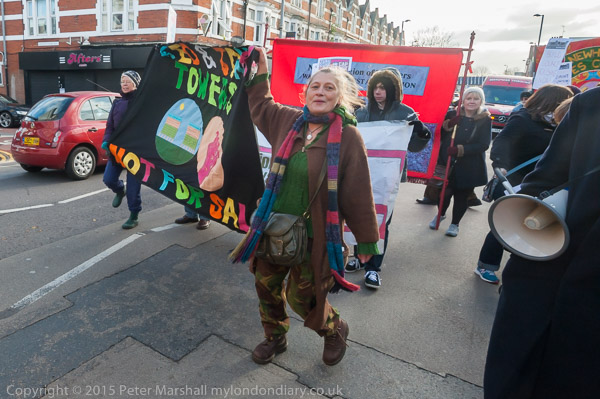
'Fred & John Towers Not For Sale' reads a banner
that residents dance with on the march
more pictures
A march from Abbots Park to a rally in the Centre of Walthamstow by Waltham Forest Housing Action called for an end to evictions and for capping of rents and a massive increase in social housing as only 400 of 12,000 homes planned in Walthamstow in the next 5 years are for low earners despite a council waiting list of over 20,000 families.
The event included many groups concerned with housing in the area which has similar problems to most of London, with 'regeneration' pricing local people out of London and new properties being built which are beyond the reach of those in the many lower paid and middle-income jobs which are essential for the city to run. Average rents in the area are much higher than the maximum set by housing benefit
Among those backing the march and speaking at the rally in the park before it moved off were teachers; as an NUT speaker pointed out low public sector pay rises in recent years combined with rising house prices and private sector rents mean that teachers can no longer afford to come to live in London. Other essential workers are also in the same position, and the march was led by the Fire Brigades Union's fire engine, which also provided a platform for the speakers.
Others who spoke before the march set off included Linda Taafe of the TUSC and Secretary of Waltham Forest Trades Council and Green Party Deputy Leader Dr Shahrar Ali. Among the groups with banners were the residents of Residents of Fred Wigg and John Walsh towers on the edge of Wanstead Flats in Leytonstone. The 234 social housing units on the site will only be replaced by 160 and new private flats will be sold to raise £30 million.
Waltham Forest also has twice the eviction rate of the average London borough and Unite Community Waltham Forest and others in Waltham Forest Housing Action are advice and sharing campaigns on welfare benefits and organising eviction resistance.
The only real solution to London's housing crisis is a crash programme to
build more genuinely affordable housing - which means council housing. Relatively
few of the workers that London needs can afford the £500,000 homes and
£1500 per calender month rents that the private sector provides.
more pictures
Kingston Christmas
Kingston-upon-Thames, London. Thu 19 Nov 2015
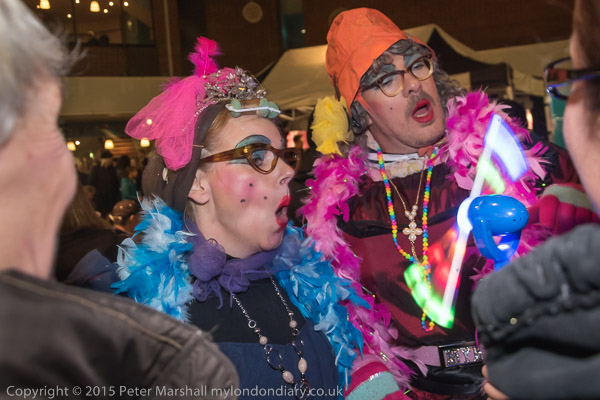
Molly and Myrtle add a little fun to the event in the
town centre
more pictures
Kingston is a major shopping centre, and Christmas the main shopping festival of the year was celebrated with the switching on of the Christmas lights and the opening of the Christmas market in the town centre. Though apart from a few more lights and some largely bad music, Christmas trading doesn't seem to be a great deal different to the rest of the year. And fortunately there is at least one decent pub in the market area; this was an event which required some respite.
There were a few special events taking place around the town centre, and a lot of people had come to the event in the hope of being entertained, though entertainment seemed a little thin on the ground. There seemed to be more council people with clipboards taking surveys than anything else on the streets.
Kingston isn't a place I much like, though it has a good local museum, and
produced one of the more intriguing figures in nineteenth century photography,
the notably eccentric Edweard Muybridge, who emigrated to California where
he took the first pictures of figures in motion with a series of cameras tripped
by a galloping horse at Palo Alto, was tried for murder and made some grand
images of dramatic landscapes in what became one of the US's best-known national
parks - where later Ansel Adams also made his name.
And back in 2007, I had a show at Kingston Museum together with
Paul Baldesare and Mike Seaborne, Another
London. It was hard work then to find some images from Kingston to include,
though 5 of my 26
on the web site include three from Kingston as well as two from Surbiton
and one from New Malden, also in the London Borough of Kingston. Two however
were from Kingston carnival, bought in from more inner areas of London. Kingston
itself still clings to its Surrey roots, with the Surrey county offices still
there.
more pictures
MfJ 'Set Her Free' protest at Yarl's Wood
Yarl's Wood, nr Bedford. Sat 7 Nov 2015
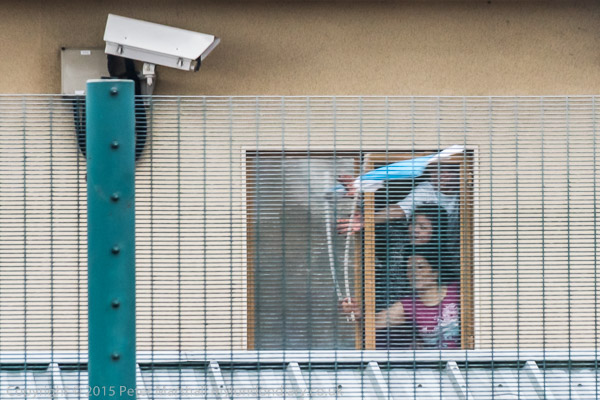
Women imprisoned in Yarl's Wood come to the window to
greet the protesters
more pictures
Movement for Justice protesters waved and shouted at the women inside the prison, calling for an end to racist immigration detention. The prisoners came to the windows and joined in the protest. Ladders were used to put a large banner on the fence.
The gates to the Business Park were closed to the protesters and to get to the Yarl's Wood immigration prison we had to walk along a public footpath for around half a mile. The gate to the field adjoining the prison fence had been left open and unguarded to allow the protesters access, and they marched in as women inside shouted greetings and waved from the upper floor windows.
The windows only open an inch or two, but some women managed to hold posters through the gap while others waved towels or clothing. One read 'We came to seek Refuge. Not to be locked up' and another 'We are from torture. We Need Freedom'.
The prison fence is around 20ft tall. The first 10 foot is solid metal, but above that is another 10 ft of mesh through which we could see the women by climbing up a slope in the field a few yards back from the fence.
Down at the fence, the fence is all you can see. but some of the protesters were able to make a great deal of noise by banging and kicking the metal fence. A large group of protesters arrived dressed in black and masked, carrying large banners, one reading 'No Borders No Nations Stop Deportations' and a larger one with the message 'Shut Down Yarl's Wood and all detention centres'. They used poles to hook a couple of flexible ladders over the top of the fence and climbed up to take this long banner up to the top of the fence.
While this was happening there were a couple of tremendous downpours. The ground by the fence had already been waterlogged, and now became a greasy mess of ridges with long puddles in the dips between. I put up an umbrella to try and keep dry and working, but the rain still got inside one of my two cameras. The lens steamed up a little, but later I found there were actual small drops on the sensor which ruined many of my pictures, though later I was able to crop or retouch some. I wasn't able to see this was happening because the view was so steamed up, and it was only clear to see when the lens had dried out. It's not something I've seen before.
After these two massive showers the sun came out, which started to dry us all off. The protest continued, with a loudspeaker system conveying the campaigners' speeches and chanting to those inside as well as the protesters who were spread widely across the field along the length of the wing (one of three parallel wings in the prison.) We got to hear those inside too, both to hear them joining in the chanting of 'Detention Centres - Close them Down' and other slogans and also at greater length when some were able to talk via mobile phone. Some of the phones used outside had a line out socket which gave a much clearer link than using the phone speaker at previous protests.
A few days after the protest, the courts refused to allow the government
to appeal against the ruling that 'detained fast track', a system expressly
designed to make it difficult or impossible for asylum seekers to prove their
case, was illegal. Bit by bit the campaign against the racist immigration
system is making its point.
more pictures
MFJ Meet Outside Yarl's Wood
Twinwoods Business Park, nr Bedford. Sat 7 Nov 2015
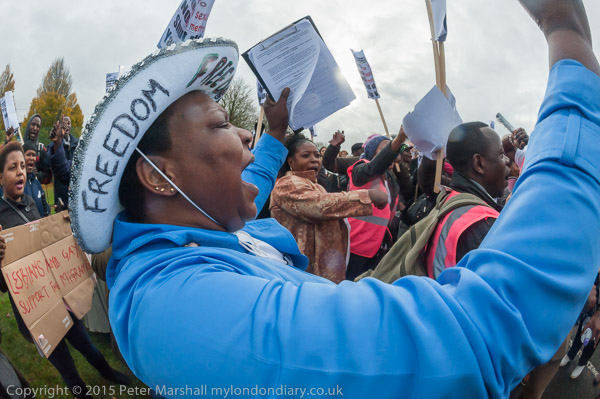
MfJ campaigners shout for immigration detention centres
to be closed down
more pictures
Around a thousand Movement for Justice campaigners met up on Thurleigh Rd outside Twinwoods Business Centre before marching to Yarl's Wood to protest in front of detention prison calling for it all all others to be shut down. Refugees and asylum seekers deserve humane treatment not imprisonment.
It took quite a while for the coaches from all around the country- including 8 from London (and others came by train to Bedford before getting a coach from the station) to arrive on the wide verge at the front of the business estate. Yarl's Wood detention centre is at the back of the estate, a former wartime air station.
While we were waiting for everyone to arrive there was a lively rally with
a great deal of dancing, singing and chanting, keeping everyone's spirits
high, and keeping us warm as a chilly wind with occasional spots of rain swept
across the open site on top of a high plateau.
more pictures
Students at Home Office and BIS
Westminster, London, Wed 4 Nov 2015
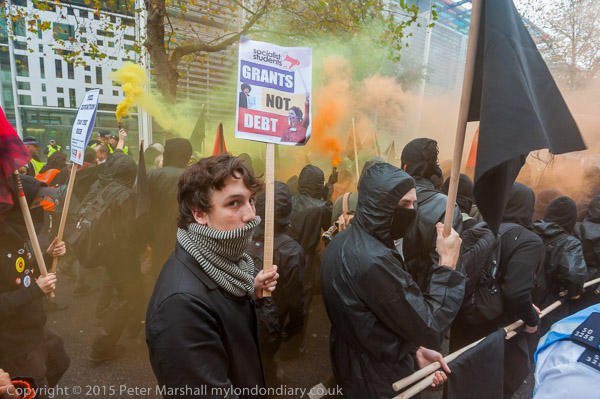
Black bloc protest with flares outside the Home Office
calling for no borders
more pictures
From Parliament Square, the national march by students for free education
went on to the Home Office and Dept of Business, Innovation & Skills,
where a black clad block charged the mass of police protecting the building,
but were forcefully repelled.
There was coloured smoke in the air when I reached the Home Office, catching up with the protest just as those at the front were moving off. The black bloc, with a large police escort, continued to protest with more flares for a few minutes, until moving off to catch up.
The march stopped next outside the Dept of Business, Innovation & Science, which is now responsible for the universities which are no longer seen by government as a part of education. I photographed the students standing around outside the BIS building when I heard a roar and turned to see the black bloc charging the line of police in an attempt to enter the BIS.
It was something of a half-hearted attempt, with most of those behind the front couple of rows simply standing back and watching, and not unsurprisingly the police line held. Others then joined in, but police reinforcements soon arrived and after a few minutes of standing back and staring at each other through some red smoke the black bloc attempted to move off down the road, but were stopped by a line of police.
They began to push their way along the road but were then charged from the side by a more disciplined group of around 40 police, trapping a several photographers and peaceful protesters who received minor injuries before the police pulled back for another stand-off between them and the students over a road now littered with broken 'book' placards. This time the smoke was yellow.
The students made another attempt to march away down the road and were stopped by a line of police across the road. Over half of the student marchers had already moved on past this, but most of those stopped were still entirely peaceful protesters, who asked politely to go through the line but were stopped. I tried to go through showing my press card but was refused several times. I was told by one officer I would be let through if I showed my card at the end of the line, but they would not do so, and when I went back and told him this he asked me to duck under his arm and I did so.
I joined the others who were watching the line and the students behind it,
taking a picture or two, but they were making no attempt to break through,
just standing around and I moved on to photograph some of the other marchers
further down Victoria St. Deciding I was tired and it was time for me to go
home I turned down a side street and as I walked away heard a lot of noise
and turned to see the students who had been confined running down Victoria
St to continue their march, having broken through the police line. I decided
not to follow them.
more pictures
'Welcome Home Shaker' celebration
Parliament Square, London. Wed 4 Nov 2015
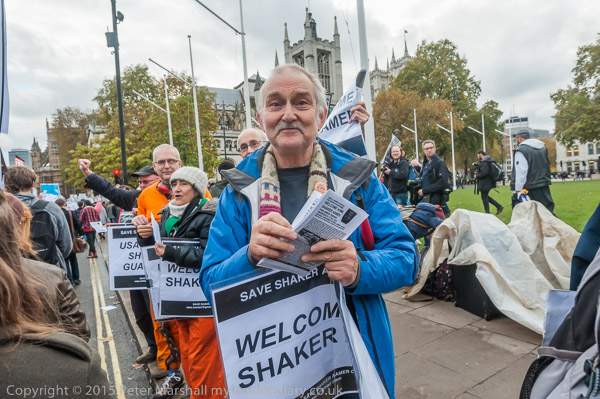
Ray Silk from the Save Shaker Aamer Campaign was with
others in Parliament Square
more pictures
Campaigners from the Save Shaker Aamer Campaign who mounted a weekly vigil for his release opposite Parliament every Wednesday when Parliament was sitting today held a celebration in Parliament Square to welcome him home.
I stopped briefly to talk and photograph them as the student march went on
past Parliament on its way to the Home Office.
more pictures
Free Education - No Barriers, Borders or Business
Malet St to Parliament Sq, London. Wed 4 Nov 2015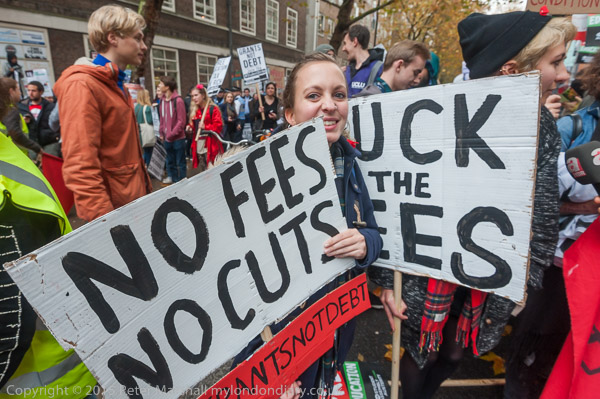
The march forms up on Malet St
more pictures
A march in London by the National Campaign Against Fees and Cuts (NCAFC) protested against the abolition of maintenance grants, calling for free education without fees and huge student debts and an end to turning higher education into a market system impoverishing staff and students.
There were a number of speeches in Malet St, where the march formed up including those by Shadow Chancellor John McDonald and Antonia Bright of Movement for Justice. As well as the issues of student fees and loans, the march also called for an end to borders and the scapegoating of immigrants.
Shortly before the march moved off it was joined by around a hundred black
clad and masked students in an autonomous bloc towards the rear of the march.
At there front were a 'book bloc', a line of protesters with large polystyrene
padded posters with the names of left wing and anarchist classic books on
them or slogans such as 'Rise, Riot, Revolt.
The march moved off going through Bedford Square and down to High Holborn
where it turned west and then took Shaftesbury Ave and the Charing Cross Rd
to Trafalgar Square.
A few flares were lit by the autonomous bloc on the Charing Cross Rd, and
by them and others on Whitehall, but the march proceeded peaceful to Parliament
Square, where I left it for a few minutes to photograph another event.
more pictures
top of page
All pictures on this site are Copyright
© 1999-2019 Peter Marshall ; all rights reserved.
for licences to reproduce pictures or to buy prints or comment on the work,
Payment may be waived for acceptable non-profit
use by unfunded bodies.
But organisations that pay any staff should also pay photographers.
